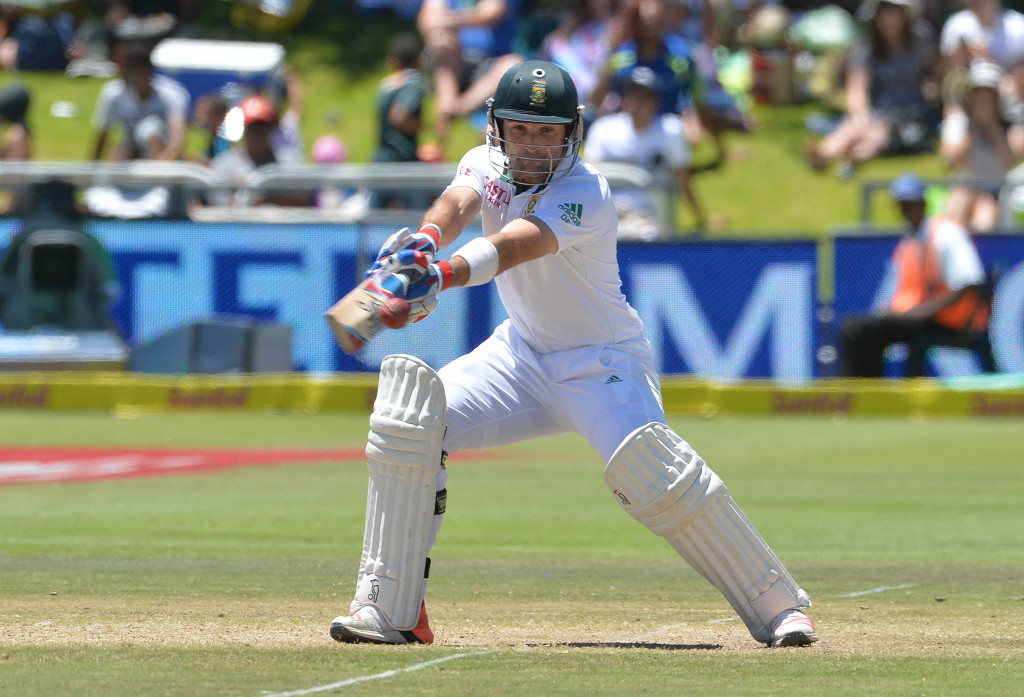What on earth did Dean Elgar and Faf du Plessis have for lunch in Chittagong? Sleeping tablets?
From a comfortable 104-1 in the 28 overs before the break on the opening day, both batsmen retreated into their shells – and ultimately paid the price with both their wickets falling in the space of three balls. Their departures seemed to drive fear into the hearts of the rest of the batting line-up.
It has to be said right here though that the Proteas batsmen looked woefully out of form. Hashim Amla played a loose stroke away from his body, JP Duminy over-balanced and was trapped in front first ball and Quinton de Kock was too late with his defensive push and was bowled second ball. From a lunchtime score of 104-1, the second session (29 overs) produced 64 runs for the loss of two wickets. In the final session they slipped to 174-6, batsmen trapped like rabbits in the headlines. Five wickets fell for 70 runs. Then, another flurry and suddenly they were all out for 248.
It was not that kind of a day-one pitch!
There was little menace in this flat surface and the Bangladesh spinners were searching for wickets after the lunch break more in hope than expectation.
But contrast the manner in which Elgar and Du Plessis batted after the interval. In successive overs before the break Du Plessis had struck two boundaries, the first of them using his feet well to clip Taijul Islam over mid-wicket to the fence. He went into the hut unbeaten on 33, with five boundaries. Elgar at the other end was solid on 30, with two boundaries.
At that 104-1 at a comfortable run-rate of 3.71 to the over, the stage was set for the South Africans to kick on after the interval. Stiaan van Zyl had earlier departed for a breezy 34 off 49 balls as he and Elgar had put on 58 for the first wicket in 14 untroubled overs.
After lunch though, the Proteas pair became marooned in their crease and adopted a defensive mindset. In the 19 overs after the interval only 32 runs were scored at a rate of 1.68 to the over. The pitch remained dry and flat and the Bangladeshi spinners were in containing mode. Instead of pushing on and asserting their authority though, Elgar and Du Plessis began a war of attrition. The runs dried up and Bangladesh were allowed to play to their own strengths.
In those 19 overs there was only one boundary, while there were nine maidens. Yes, virtually half of the overs bowled were maidens. There was very little rotation of the strike, very little in the way of pushing into the gaps, very little done to ensure the left-right batting combination disrupted the rhythm of the Bangladeshi bowlers.
Elgar was then caught behind for 47 and Du Plessis was trapped in front for 48 two balls later. I’m not suggesting that either should have gone into ‘T20’ mode and there is a lot to be said about consolidating an innings and laying the platform for a big first-innings score. However, one would come to expect more from an opener and the No 3 batsman in this situation, given that the Proteas are the No 1-ranked team in Test cricket and Bangladesh are languishing at No 9.
After the pair departed Hashim Amla, who had just come to the crease, was joined by Temba Bavuma, who looked to play positively despite the mayhem around him. Immediately the mindset of Bavuma was more positive – just like it had been for Elgar and Du Plessis in the opening session of the match.
But they allowed themselves to be knocked back by the spinners and a 19-year-old left-arm paceman on debut, Mustafizur Rahman, who cleaned up Amla, Duminy and De Kock in quick succession. Can you just imagine what Mitchell Starc or Mitchell Johnson would have done to this Proteas middle-order, missing AB de Villiers. It was a rank poor day at the office.







